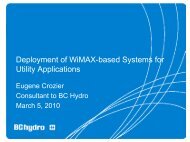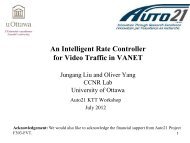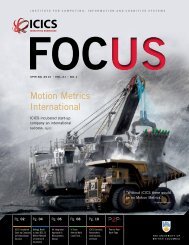On the analysis of periodic mobility behaviour - ICICS
On the analysis of periodic mobility behaviour - ICICS
On the analysis of periodic mobility behaviour - ICICS
Create successful ePaper yourself
Turn your PDF publications into a flip-book with our unique Google optimized e-Paper software.
Faculty <strong>of</strong> Computer Science<br />
<strong>On</strong> <strong>the</strong> Analysis <strong>of</strong> Periodic<br />
Mobility Behaviour<br />
Zhiyu Wang<br />
Mario A. Nascimento<br />
Mike H. MacGregor<br />
FROM SUN MICROSYSTEMS<br />
© 2008
Department <strong>of</strong> Computing Science<br />
Motivation<br />
§ Routing in delay tolerant mobile networks (DTMNs)<br />
is very challenging<br />
– <strong>On</strong>e solution is to explore user <strong>mobility</strong><br />
§ Previous studies investigate:<br />
– Encounter probabilities<br />
– Social connectivity<br />
§ We focus on <strong>periodic</strong> encounter <strong>behaviour</strong>s<br />
© 2006
Department <strong>of</strong> Computing Science<br />
Routing in DTMNs<br />
C Source<br />
D Destination<br />
D<br />
© 2006
Department <strong>of</strong> Computing Science<br />
Routing in DTMNs<br />
C Source<br />
D Destination<br />
D<br />
A Relay<br />
© 2006
Department <strong>of</strong> Computing Science<br />
Routing in DTMNs<br />
C Source<br />
D Destination<br />
D<br />
A Relay<br />
B Relay<br />
© 2006
Department <strong>of</strong> Computing Science<br />
Routing in DTMNs<br />
C Source<br />
D Destination<br />
A Relay<br />
B Relay<br />
Indirect Delivery<br />
D<br />
© 2006
Department <strong>of</strong> Computing Science<br />
Routing in DTMNs<br />
C Source<br />
D Destination<br />
D<br />
© 2006
Department <strong>of</strong> Computing Science<br />
Routing in DTMNs<br />
C Source<br />
D Destination<br />
Direct Delivery<br />
D<br />
© 2006
Department <strong>of</strong> Computing Science<br />
Encounter Series<br />
Nodes<br />
I 0 I 1 I 2 I 3 I 4 I 5<br />
A B 1 0 1 0 1 0<br />
A C 0 1 0 1 0 0<br />
A D 0 0 0 0 0 0<br />
T<br />
B C 0 0 0 0 0 0<br />
B D 0 1 0 1 0 0<br />
C D 0 0 0 0 0 1<br />
§ Encounter series are<br />
binary time series<br />
§ The objective is to<br />
find <strong>periodic</strong><br />
encounter patterns<br />
© 2006
Department <strong>of</strong> Computing Science<br />
Periodicity recognition<br />
§ APG examines conditional probabilities <strong>of</strong> encounters at different<br />
lags in encounter series.<br />
– Peaks are formed by underlying <strong>periodic</strong> encounters at corresponding phases<br />
§ If an encounter series has <strong>periodic</strong> <strong>behaviour</strong> with length p, <strong>the</strong>n<br />
it also has <strong>periodic</strong> <strong>behaviour</strong> with length 2p, 3p and so on.<br />
© 2006
Department <strong>of</strong> Computing Science<br />
Periodicity recognition<br />
Periodic encounters detected<br />
Period length distribution<br />
No long-term<br />
<strong>periodic</strong>ity<br />
© 2006
Department <strong>of</strong> Computing Science<br />
Persistence <strong>of</strong> <strong>periodic</strong> <strong>behaviour</strong><br />
§ Two thresholds<br />
– θ = <strong>the</strong> degree to which <strong>the</strong> number <strong>of</strong> <strong>periodic</strong> encounters<br />
within an interval match those in a discovered pattern<br />
e.g.<br />
θ =1/<br />
2<br />
if only one <strong>periodic</strong> encounter is found in <strong>the</strong> current interval<br />
when <strong>the</strong> pattern detected contains two encounters, e.g., <strong>the</strong> pattern<br />
detected is 0100100 vs. <strong>the</strong> actual encounter 0000100<br />
– Δ = <strong>the</strong> maximum number <strong>of</strong> intervals not satisfying θ<br />
© 2006
Department <strong>of</strong> Computing Science<br />
Persistence <strong>of</strong> <strong>periodic</strong> <strong>behaviour</strong><br />
matching probability,<br />
θ<br />
# <strong>of</strong> missing intervals,<br />
Δ<br />
© 2006
Department <strong>of</strong> Computing Science<br />
Conclusion<br />
§ Three contributions:<br />
– discovered strong daily and weekly patterns in Nokia-MDC<br />
datasets<br />
– evaluated <strong>the</strong> persistence <strong>of</strong> <strong>periodic</strong> <strong>behaviour</strong><br />
– examined <strong>the</strong> small-world structure in <strong>the</strong> network formed<br />
by <strong>periodic</strong> <strong>behaviour</strong><br />
§ Exploring <strong>periodic</strong> encounter <strong>behaviour</strong> for routing<br />
in DTMNs.<br />
© 2006
Department <strong>of</strong> Computing Science<br />
Thank you!<br />
Questions?<br />
© 2006







